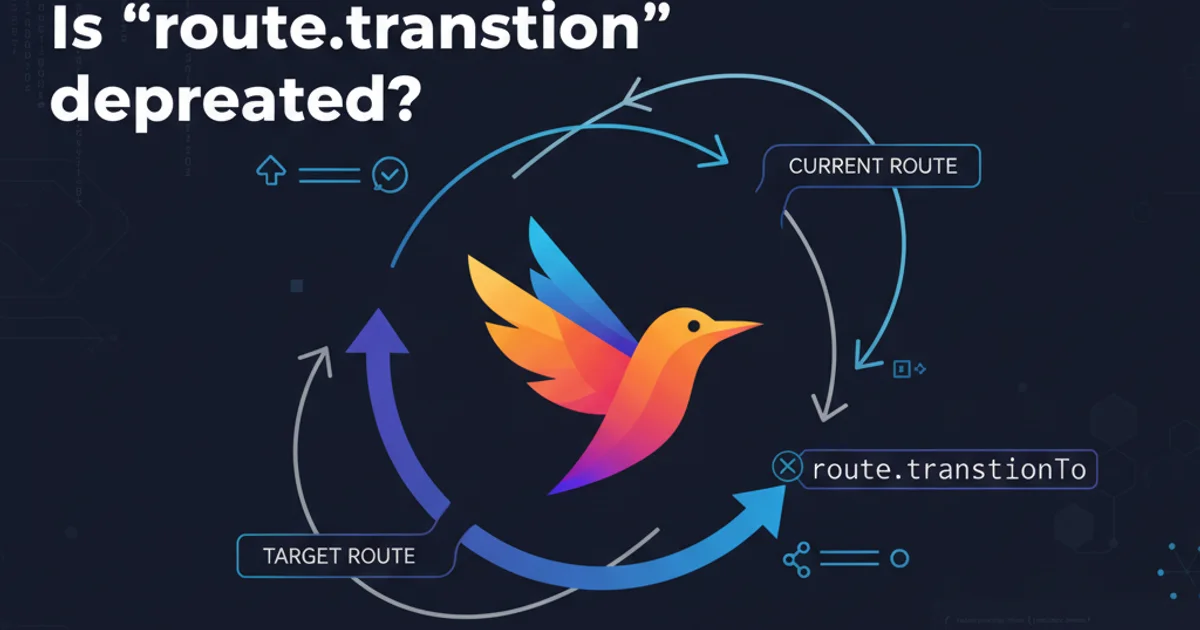Is `route.transitionTo` deprecated?
route.transitionto deprecated? with practical examples, diagrams, and best practices. Covers javascript, ember.js, routes development techniques with visual explanations.Categories:
Is route.transitionTo Deprecated in Ember.js?

Explore the evolution of route transitions in Ember.js, understand the current best practices, and clarify the status of route.transitionTo.
Ember.js, a framework known for its stability and convention over configuration, occasionally evolves its APIs to improve developer experience and performance. One area that has seen changes over the years is route transitions. Developers often wonder about the status of methods like route.transitionTo and whether they are still considered best practice or have been deprecated. This article clarifies the current state of route transitions in Ember.js, guiding you through the recommended approaches.
Understanding transitionTo in Ember.js
Historically, transitionTo has been a fundamental method for navigating between routes in Ember.js. It allows programmatic navigation, which is essential for actions like form submissions, authentication redirects, or dynamic content loading. The method exists in several contexts within an Ember application, primarily on the RouterService and the Route object itself.
// Example of using transitionTo within a Route
import Route from '@ember/routing/route';
import { action } from '@ember/object';
export default class PostRoute extends Route {
@action
editPost(postId) {
this.transitionTo('posts.edit', postId); // Using route.transitionTo
}
}
Basic usage of this.transitionTo within an Ember Route.
The Rise of the Router Service
While route.transitionTo is not formally deprecated, the Ember team has increasingly encouraged the use of the RouterService for programmatic transitions. The RouterService provides a more consistent and testable API for navigation across your application, whether you're in a component, controller, or service. Injecting the RouterService allows you to perform transitions without direct access to the Route object, promoting better separation of concerns.
// Example of using RouterService for transitions
import Component from '@glimmer/component';
import { inject as service } from '@ember/service';
import { action } from '@ember/object';
export default class PostCardComponent extends Component {
@service router;
@action
viewPost(postId) {
this.router.transitionTo('posts.detail', postId); // Using router.transitionTo
}
}
Using the RouterService for programmatic navigation from a component.
RouterService (this.router.transitionTo(...)) over this.transitionTo(...) directly on the Route object. This provides a more consistent API and simplifies testing.Why the Shift to RouterService?
The move towards RouterService is driven by several factors:
- Consistency: It provides a single, unified API for navigation regardless of where you are in your application's component hierarchy or service layer.
- Testability: Injecting the
RouterServicemakes it easier to mock and test navigation logic in isolation. - Future-proofing: As Ember evolves, the
RouterServiceis the primary interface for router interactions, making your code more resilient to future changes. - Clarity: It explicitly states that you are interacting with the application's router, rather than relying on the implicit context of a
Route.
flowchart TD
A[User Action] --> B{Component/Service/Route?}
B --> C1[Inject RouterService]
B --> C2[Access Route Object]
C1 --> D1["router.transitionTo('route.name')"]
C2 --> D2["this.transitionTo('route.name')"]
D1 --> E[Ember Router]
D2 --> E
E --> F[New Route Rendered]
style C1 fill:#bbf,stroke:#333,stroke-width:2px
style D1 fill:#bbf,stroke:#333,stroke-width:2px
linkStyle 0,1,2,3,4,5 stroke:#333,stroke-width:2px,fill:none;Comparison of RouterService vs. Route object for transitions.
route.transitionTo is not officially deprecated and will continue to work, adopting RouterService is considered a best practice for modern Ember applications.Practical Steps for Modern Transitions
To ensure your Ember application uses the most up-to-date and maintainable approach for route transitions, follow these steps:
1. Inject the RouterService
In any component, controller, or service where you need to perform a transition, inject the RouterService. This makes the router instance available as this.router.
2. Use this.router.transitionTo()
Replace any instances of this.transitionTo() (when called directly on a Route or Controller instance) with this.router.transitionTo(). The arguments remain the same.
3. Review Existing Code
Perform a codebase audit to identify and update older transition patterns. This is especially relevant for applications that have been upgraded through multiple Ember versions.
In conclusion, route.transitionTo is not deprecated in Ember.js, but the RouterService provides a superior and recommended approach for programmatic route transitions. By embracing the RouterService, you contribute to a more consistent, testable, and future-proof Ember application.